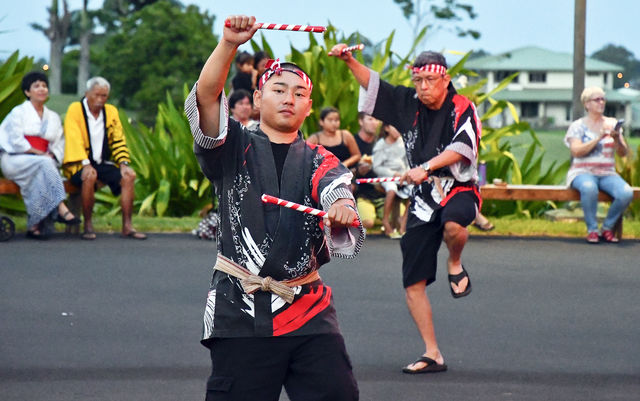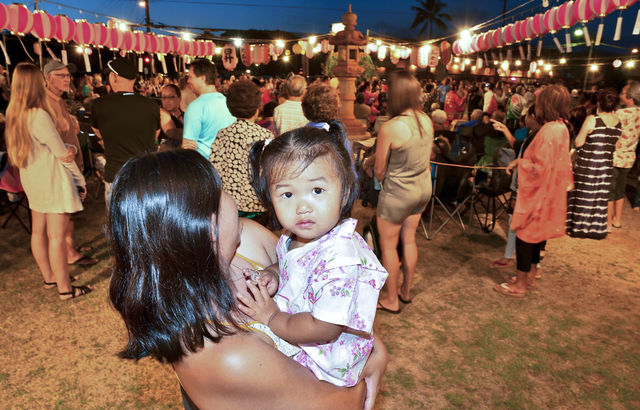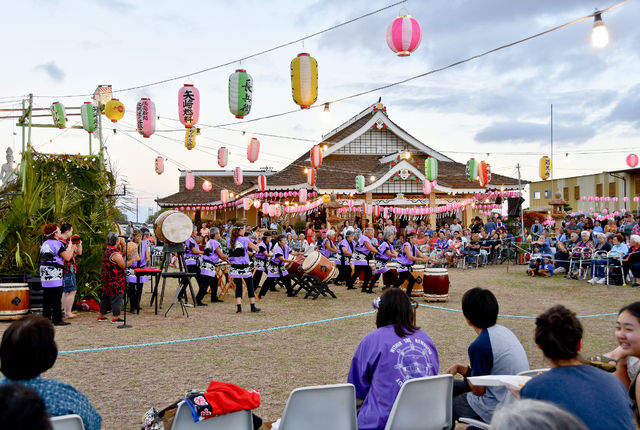One piece of advice for Friday night — go early! The West Kauai Hongwanji Mission, Hanapepe Temple, on Kaumuali‘i Highway adjacent to the Hanapepe Public Library will host its annual bon dance Friday and Saturday with bon dancing scheduled to
One piece of advice for Friday night — go early!
The West Kauai Hongwanji Mission, Hanapepe Temple, on Kaumuali‘i Highway adjacent to the Hanapepe Public Library will host its annual bon dance Friday and Saturday with bon dancing scheduled to start at 7:30 p.m.
Parking will be at a premium Friday night because the bon dance coincides with Hanapepe Art Night from 5 to 9 p.m.
“At the peak hour of our bon dance, about 8 p.m., we had an estimated 2,500 people on the grounds of the Hanapepe Soto Zen Temple, July 22,” said Gerald Hirata, president of the Hanapepe Soto Zenshuji Temple. “We had a free shuttle bus service moving people from the bon dance to the Art Night, and had Tsunami Taiko performing outside the Hanapepe Hawaiian Church as a teaser for the bon dance.”
Joanna Carolan of the Banana Patch Studios said she and her family took advantage of the shuttle service to enjoy the bon festivities, which included unique local food offerings like flying saucers, pronto pups, saimin and more prepared under the supervision of Chef Carla Dusenberry.
“We also opened up the Hanapepe Ball Park to parking to accommodate the heavier than normal traffic,” Carolan said.
The WK Hongwanji, Hanapepe Temple will have the same traditional bon dance food offerings. People should expect to stand in line for the coveted flying saucers, a unique Kauai delicacy which appears to taste its finest during bon season.
Bon stems from the Buddhist religion where it is believed that spirits of departed loved ones return to earth during o-bon and people on earth take this opportunity to reunite with the spirits, paying respect and appreciation for them. Following the bon season, the spirits depart to their world, some Buddhist sects sending the spirits off in elaborate ceremonies such as the fire burning ceremony at the Hanapepe Soto Zen temple, or the toro nagashi, or lantern sendoff, practiced by the Jodo Mission temples.
The practice was brought to Hawaii by the Japanese immigrants who came over to labor on the plantations. Through the years and through association with other ethnic plantation camps, the current Hawaiian style bon dance evolved and continues to flourish.
“This is not anything like that is practiced in Japan,” said Yoshi Tsurumi, adviser and teacher for The Change Academy who was on Kauai with his students from rural Japan high schools in July. “The Kauai bon dances are more traditional and performed in the traditional way. In Japan, it’s more lively and modern.”
As a way of getting to know the rural lifestyle of Kauai better, Yoshi had his students spend a day volunteering at the Kauai Soto Zen event, stringing lanterns of remembrance, or chochin, and the Kauai Community College arranging to have host families meet their students at the bon dance.
The WK Hongwanji, Hanapepe Temple will close the season of bon dances hosted by the Kauai Buddhist Council that started during the first weekend of June.
Another bon dance, this one at the Samuel Mahelona Memorial Hospital, will take place Aug. 12 and will get the help of Kauai Buddhist Council bon dance participants as the event unfolds for the benefit of the hospital’s residents who are not physically capable of attending the community bon dances.
“We have been doing bon dance for more than 15 years at the hospital,” said Josie Pablo, Mahelona Hospital recreation director. “A lot of the residents lived with bon dance, and now, if they’re not able to go to bon dance, we bring the bon dance to them. We also take residents who are capable to enjoy the bon dance to the events at our Kapaa churches’ bon dances.”




